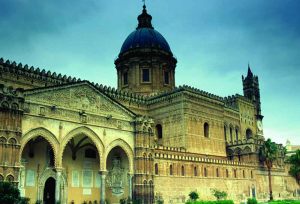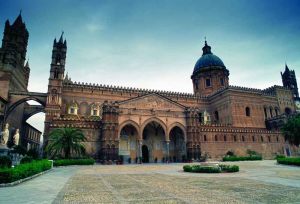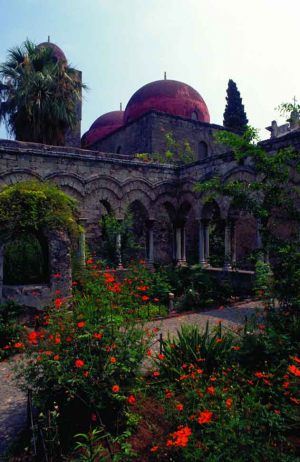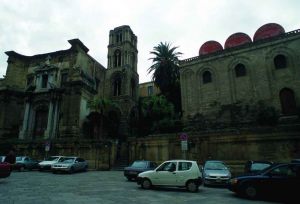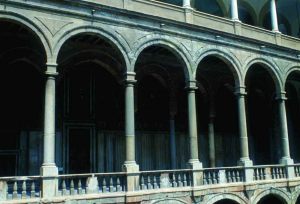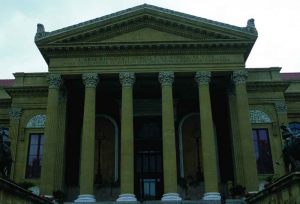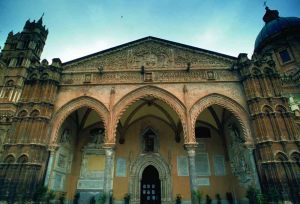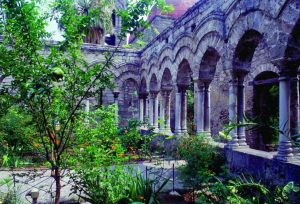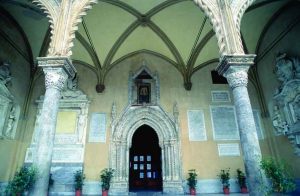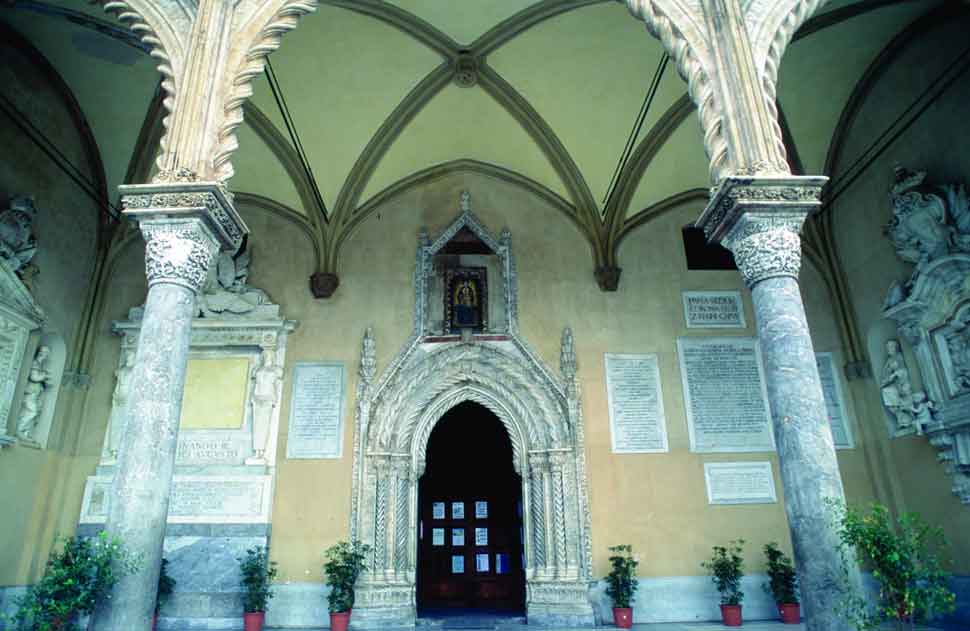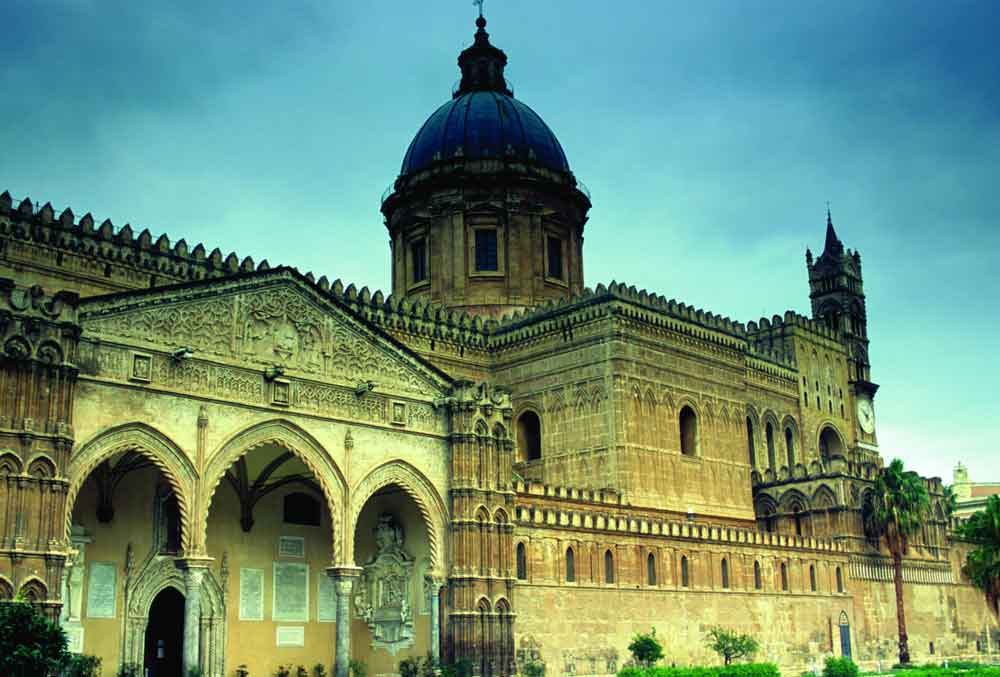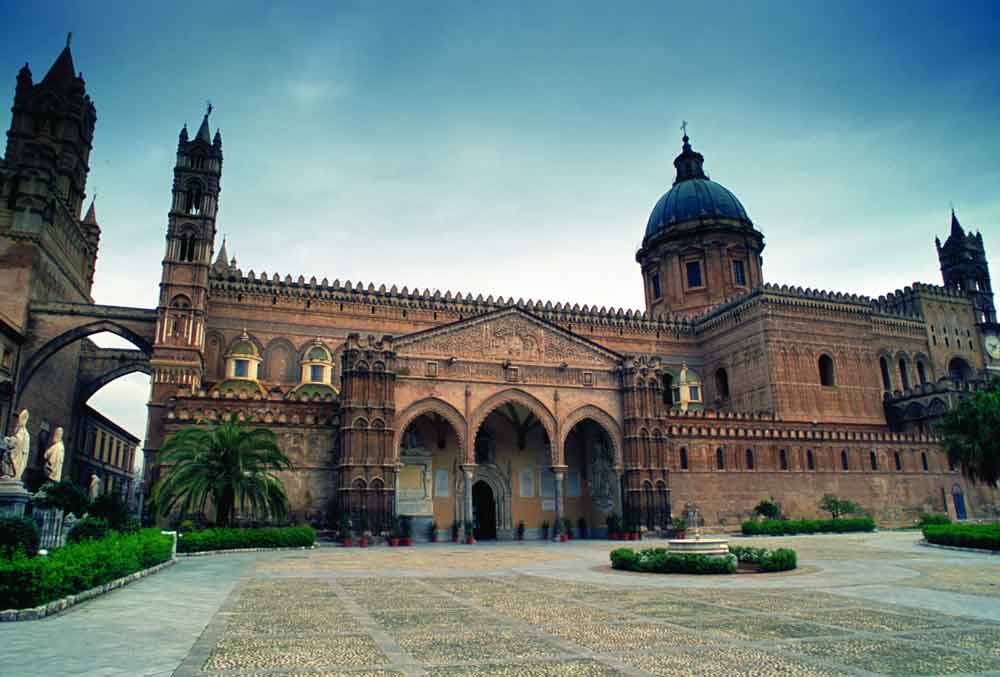Sicily Region
Sicily is a Region with a special Statute, endowed with wide autonomy, both political and administrative and financial.
The separatist pressures have always characterized Sicilian political history. In the aftermath of the Allied landing in July 1943, in fact, the Sicilian Independent Movement, which emerged from the clandestinity that had characterized it during the fascist period, asked for the liberation of Sicily from the Kingdom of Italy and constituted a paramilitary organization, the Army Volunteer for the Independence of Sicily (EVIS) led by Antonio Canepa.
The special Sicilian statute, was issued by King Umberto II on 15 May 1946 precisely for the purpose of curbing the MIS; gave birth to the Sicilian Region even before the birth of the Italian Republic. The founding fathers of the Sicilian statute supported a substantial, but not antithetic, juridical, historical and political equality between the Sicilian people and the Italian people. It is no coincidence that Sicily is the only region of Italy where the legislative body is also called parliament.
The special statute and exclusive competences
The Region has exclusive competence over a series of subjects including: cultural heritage, agriculture, fishing, local authorities, environment, tourism, forest police. Any amendment to the special statute, being a constitutional law, is subject to the so-called aggravated procedure, ie a double approval, by qualified majority, by the chambers
The Flag and the Coat of Arms of the Sicilian Region have the colors yellow and red, divided diagonally, with the Triscele and the Gorgoneion in the center.
The Official Anthem, was composed by Vincenzo Spampinato and performed for the first time by the Sicilian Symphony Orchestra; Madreterra, in 2003, was the first official anthem to be adopted by an Italian region.
- Coordinate Cap. 37°30’00” N
- Coordinate Cap. 14°00’00” E
- Altitudine 3.340 m s.l.m
- Superficie 25.832,39 km²
- Abitanti 5.055.925
- Densità 195,72 ab/km²
- Liberi Consorzi 6
- Città Metropolitane 3
- Comuni 390
Administrative division
In ancient times the territory was divided into Val di Mazara, Val di Noto and Val Demone. At the beginning of the 20th century there were seven provinces: Castrogiovanni, then Enna, and Ragusa reached the status of capitals only, respectively, in 1926 (from the dismemberment of the provinces of Catania and Caltanissetta) and in 1927 (with the acquisition of part of the municipalities of the province of Syracuse). Agrigento was called Girgenti. The nine regional provinces were established in the seventies as consortia of municipalities; previously, in 1946, the Statute had sanctioned the abolition of provincial administrations. To date, Sicily is divided into 390 Municipalities, gathered in 6 Free municipal consortia and 3 Metropolitan Cities that perform coordination, planning and control functions in territorial, environmental, transport and economic development matters.
The free municipal consortia of Sicily are: Agrigento, Caltanissetta, Enna, Ragusa, Syracuse and Trapani; include the territories that were of the Regional Provinces. The metropolitan city of Palermo covers an area of 5.009.28 km² and includes 82 municipalities. It is the fifth Italian metropolitan city by population and the third by size. Its territory coincides with that of the former Province of Palermo. The metropolitan city of Catania includes the 58 municipalities of the former regional province of Catania. The metropolitan city of Messina covers an area of 3 266.12 km²; was established with the regional law n. 15 of 4 August 2015 and its territory coincides with that of the suppressed regional Province of Messina. With its 108 municipalities, it is the first by territorial subdivision in front of the other free municipal consortia and Sicilian metropolitan cities.
Amministrazione
The legislative body is constituted by the Sicilian Regional Assembly, the executive one by the President of the Sicilian Region and the Regional Council, composed of 12 regional councilors who, since 2001, may not even be members of the ARS. The Sicilian Regional Assembly is based in Palermo, at the Palazzo dei Normanni . The Sicilian parliament, born in 1130, is considered the oldest in Europe. The regional presidency is based in Palermo, at Palazzo d’Orleans.
The President of the 59th Regional Council, elected on November 18, 2017, is Nello Musumeci, the official candidate of the movement. – Us with Salvini. Born in Militello in Val di Catania on 21 January 1955, he served as MEP from 1994 to 2009 and undersecretary at the Ministry of Labor and Social Policy in 2011 in the Berlusconi IV government. Graduated in Communication Sciences at the Kore University of Enna, he worked as a banker in the Unicredit Group and is a journalist. He taught at the Higher Institute of Journalism in Acireale and is the author of historical essays on twentieth-century Sicily. On May 23, 2013 he was unanimously elected President of the Regional Anti-Mafia Commission of the Sicilian Regional Assembly. It proposes the creation of a European observatory on the phenomenon of mafias and calls for the establishment of a time of legality to educate the very young by doing culture of legality in schools. In September 2014 Musumeci is among the founders of the Sicilian civic movement “# It will become beautiful”.
Siti Istituzionali
www.ars.sicilia.it
www.regione.sicilia.it
Giunta regionale
Gaetano Armao
Vicepresidente e Assessore all’economia
Edgardo Bandiera
Assessore all’agricoltura, sviluppo rurale e pesca mediterranea
Salvatore Cordaro
Assessore al territorio e all’ambiente
Marco Falcone
Assessore alle infrastrutture e alla mobilità
Bernadette Felice Grasso
Assessore alle autonomie locali e alla funzione pubblica
Antonio Scavone
Assessore alla famiglia, politiche sociali e lavoro
Roberto Lagalla
Assessore all’istruzione e alla formazione professionale
Alberto Pierobon
Assessore dell’energia e dei servizi di pubblica utilità
Sandro Pappalardo
Assessore al turismo, allo sport e allo spettacolo
Ruggero Razza
Assessore alla salute
Girolamo Turano
Assessore alle attività produttive
Nello Musumeci
Assessore ai Beni culturali e dell’identità siciliana
Sicily, Island of Culture
The regional territory consists of the island of the same name, the largest in Italy and the Mediterranean Sea, from the Aeolian, Egadi and Pelagie archipelagos, from the islands of Ustica and Pantelleria. It is bathed to the north by the Tyrrhenian Sea, to the west by the Sicilian Channel, to the south by the Sea of Sicily, to the east by the Ionian Sea and to the north-east by the Strait of Messina that separates it from Calabria. In ancient Sicily Sicily took the name of Trinacria or Triquetra because of its triangular shape.
Geology – Sicily belongs to the Siculo Iblea plate that is part of the African plate and, in the north-eastern part, to the Eurasian plate. The sliding of the African plate, which by subduction is immersed under the Eurasian one, has led to the creation of the mountain ranges of the region, as well as the presence of frequent seismic activities of both tectonic and volcanic origin.
Mountain reliefs – It is a predominantly hilly region (61.4% of the territory), 24.5% is mountainous and the remaining 14.1% is flat. In the Madonie rises the second highest peak of the island, Pizzo Carbonara (1,979 meters). At the center of Sicily there are the Erei Mountains on which is located, at 948 meters high, the city of Enna; in the south-eastern area, between the province of Ragusa and that of Syracuse, we find the Iblei Mountains. To the west there are the Sicans and the mountains that surround the Conca d’Oro, the plain on which Palermo extends. To the east rises the snow-covered peak of Etna, 3,343 meters high.
Volcanoes – The surrounding region and islands are affected by intense volcanic activity. The main volcanoes are: Etna, Stromboli and Vulcano. They belong to three different types: eruptions of basaltic lavas interspersed with periods of calm the first; continuous eruptions and lava fountains, the second; the third is an explosive type, alternating long periods of apparent calm with sudden eruptions. We should also mention the Marsili, the largest submarine volcanic building on the old continent. The complex rises about 3,000 meters from the seabed, reaching an altitude of about 450 meters below the south-eastern Tyrrhenian Sea. The submarine landslides generated by the violent explosive eruptions make Marsili one of the main and constant tsunamigenetic sources of the entire Tyrrhenian Sea.
Rivers and lakes – Sicilian rivers have limited range and extension. Those in the Apennines, to the north, have a torrential character and are often dry in the summer. The only waterways that reach a considerable size are the Southern Imera and the Simeto which together with the Alcantara, the Agrò, the Ciane and the Anapo flows into the Ionian Sea; the Northern Imera and the Torto in the Tyrrhenian while the Platani, the Southern Imera (or Salso) and the Belice in the channel of Sicily. With the exception of Lake Pergusa and the semi-artificial lake of Biviere di Lentini, Sicily has no natural lakes. The construction of dams has created large artificial reservoirs, such as the Ancipa lake and the Pozzillo lake. Lake Arancio, Lake Ogliastro and Santa Rosalia, Lake Piana degli Albanesi should also be mentioned.
Coasts – In the north, the coasts are high and rocky, they overlook the Tyrrhenian Sea and have large inlets: the gulfs of Castellammare del Golfo, Palermo, Termini Imerese, Patti, Milazzo. To the east the Ionian coast is more varied: narrow pebble beaches up to Taormina, between the mouth of the Alcantara and Riposto rivers; the coast appears jagged towards the south, with inlets and bays like that of Giardini Naxos; lavic as in Acireale, consisting of rugged basaltic cliffs up to Catania. The Gulf of Catania has a beach of golden sand, following a rocky coast full of fjords. The wide bay of Augusta is home to the largest commercial port in Sicily, the Gulf of Syracuse with a sandy coast up to Capo Passero. To the south the coast is mostly sandy and uniform in the central part or in correspondence with the Gulf of Gela, it is rather varied in the Ragusa and in the stretches of the Agrigento and Trapani areas.
Smaller islands – The main groups of islands of the great archipelago of Sicily are the Aeolian, Egadi and Pelagie islands; the islands of the Stagnone and the Ciclopi islands, on the other hand, constitute two small archipelagos respectively to the west and east of the Sicilian island, opposite the coasts of Marsala, in the Trapani area, and of Aci Trezza, in the Catania area. Ustica and Pantelleria, in the Tyrrhenian Sea and in the Sicily channel, form two distinct municipalities in the provinces of Palermo and Trapani. The historic centers of Syracuse and Augusta are located on two islands connected to the mainland.
Climate – The climate of Sicily is generally Mediterranean, with hot summers and mild, rainy winters, the intermediate seasons are changeable. On the southern coasts the climate is influenced by African currents, summers can be torrid. Along the Tyrrhenian coast and in inland areas, winters can be harsh and typical of the continental climate. Snow falls abundantly above 900-1,000 meters. The internal mountains, in particular the Nebrodi, the Madonie and the Etna, enjoy an Apennine climate. In summer the presence of the sirocco, the wind from the Sahara, affects the climate and the scarce rainfall sometimes generates water crises in some provinces.
Parks and natural reserves – In Sicily there are the national park of the island of Pantelleria and five regional natural parks such as: Parco dei Monti Sicani (Bivona, Burgio, Cammarata, Castronovo di Sicilia, Chiusa Sclafani, Contessa Entellina, Giuliana, Palazzo Adriano, Prizzi, Sambuca di Sicilia, San Giovanni Gemini, Santo Stefano di Quisquina), Parco dei Nebrodi, Parco dell’Etna, Parco delle Madonie, Parco fluviale dell’Alcantara. The regional nature reserves established in marine areas are also of great interest. Remember: Ciane River and Saline Nature Reserve in Syracuse; Pantalica oriented nature reserve; Valle dell’Anapo and Torrente Cava Grande; Cava Randello integral natural reserve; Grotta Conza integral nature reserve; Macalube of Aragon integral nature reserve; Nature reserve Macchia Forest of the River Irminio; Oasi del Simeto nature reserve; Biviere di Gela oriented nature reserve; Oriented nature reserve Bosco di Santo Pietro, Capo Gallo oriented nature reserve; Cavagrande del Cassibile oriented nature reserve; Oriented natural reserve Fiume Fiumefreddo; Serre della Pizzuta oriented natural reserve; Isola Bella oriented nature reserve; Oriented nature reserve Monte Cofano; Monte Conca oriented nature reserve; Monte Pellegrino oriented nature reserve; Oriented natural reserve Faunistic Oasis of Vendicari; Pino d’Aleppo oriented nature reserve; Niscemi Cork oriented natural reserve; Oriented natural reserve of the Zingaro; Natural reserve of Bosco di Alcamo; Regional Nature Reserve of the Stagnone di Marsala Islands; Lake Pergusa special nature reserve. The Marine Protected Areas are: Pelagie Islands; Capo Gallo – Isola delle Femmine; Plemmirio; Island of Ustica; Cyclops Islands; Egadi Islands Marine Nature Reserve.
UNESCO World Heritage Sites
Due to their historical, artistic, archaeological and naturalistic importance, they have currently received the title of World Heritage from UNESCO:
- The Villa del Casale in Piazza Armerina, in 1997;
- Archaeological and landscape park of the Valley of the Temples in Agrigento, in 1997;
- The Aeolian Islands, in 2000;
- The late Baroque cities of Val di Noto, in 2002 (The eight cities are: Catania, Modica, Noto, Palazzolo Acreide, Ragusa, Scicli, Caltagirone e Militello in Val di Catania).
- Syracuse and the rocky necropolis of Pantalica, in 2005;
- Mount Etna, in 2013;
- Palermo Arab-Norman and the cathedrals of Cefalù and Monreale in 2015. (to visit Palazzo dei Normanni)
In the application phase:
- The lands of the Elimi: Erice, Segesta, Selinunte, Mothia and Lilibeo;
- Taormina and Isola Bella;
- The geological site of the Scala dei Turchi.
Oral and immaterial heritage of humanity
Sicily includes three inscriptions between the oral and intangible heritage of humanity:
- The Puppet Opera, in 2001;
- Sapling cultivation of the Zibibbo of Pantelleria, in 2014.
- The art of dry stone walls, in 2018.
In the application phase: The eighteenth-century technique of processing Modica chocolate.
Other awards: The island shares with the rest of the nation and six other countries (Morocco, Greece, Spain, Cyprus, Croatia, Portugal) the recognition for the Mediterranean Diet, (2013); The Rocca di Cerere Geopark and the Parco delle Madonie were included in the list of UNESCO World Geoparks on 17 November 2015.
In the protohistoric era, the cultures of Thapsos, Castelluccio, and Stentinello flourished in Sicily. Subsequently, Mexicans, Siculi and Elymians settled there. The eighth century BC he saw Sicily colonized by the Phoenicians and above all by the Greeks. The Calcidesi founded Naxos and Zancle; Syracuse was the work of the Corinthians. Naxos, in turn founded Katane and Leontinoi, the Greek Megarians founded Megara Hyblaea. In the first half of the 7th century BC Ghelas were built by the rhodium-Cretans and then Akrai and Eloro by the Syracusans. Selinunte by the megarese of Sicily and Himera, work of the calcidesi-zanclei, arose in the middle of the seventh century. At the beginning of the 6th century Akragas was founded by the Gelesi, while the Syracusans founded Kamarina. Around the middle of the 6th century BC Greeks of Calcidese origin came to Morgantina. In the VI century the west coast of the island belonged to the Carthaginians, founders of Zyz, Mozia and Solunto, while the cities of Eryx and Segesta were founded by the Elimi. Sicily became the battlefield of the Greco-Punic Eromani-Punic wars. The island was subjugated by the Romans and was part of the empire until its fall in the 5th century AD. The Sicilian territory was extensively cultivated with wheat to supply Rome, and Sicily was called the granary of Rome.
During the High Middle Ages, it was conquered by the Vandals, the Ostrogoths, the Byzantines, the Arabs and the Normans. The occupation of the island by Muslims began with the landing in 827 in Mazara del Vallo. The conquest continued slowly: in 831 Palermo was taken, in 843 Messina, in 859 Castrogiovanni. It still remained nominally under the control of the Byzantines, a strip in the east with Syracuse, which fell only in 878, and Taormina, which still ruled until 902. The Islamic occupation of Sicily ended with Rometta in 965. The Normans drove out the Arabs and founded the Kingdom of Sicily that had long life from 1130 to 1816. The Kingdom was ruled by the Angevins and with the revolt of the vespers it passed to the Aragonese. The discontent for the Angevin government, mainly linked to the tax system, resulted in the insurrection, which began on 31 March 1282, followed by the intervention of Peter III of Aragon acclaimed King of Sicily and the so-called war of Vespers between Angevins and Aragonese . The first Aragonese kings constituted the institution of parliament, an assembly of Norman origin composed of nobles, clergy and deputies of the royal or non-feudal cities, to whom the right to deliberate peace and war, to vote for taxes, was reserved. censor public officials. Under the rule of the Habsburgs of Spain (Emperor Charles V, Philip II, Philip III, Philip IV, Charles II), Sicily experienced a period of great economic, social, religious, artistic, demographic development that lasted throughout the sixteenth century until the first decades of the seventeenth century.
Two major natural disasters hit the island severely: in 1669 the Etna eruption affected Catania and the surrounding area; in 1693, the terrible earthquake that devastated Catania, Noto and destroyed, in whole or in part, about fifty centers in the Val di Noto, immediately causing 60,000 victims. Viceroyalty of Spain, Sicily then passed to the Savoys and to Austria and, finally, in the XVIII century, to the Bourbons. These united the Kingdom of Sicily to the Kingdom of Naples; the Kingdom of the Two Sicilies arose in 1816. In 1860, during the Risorgimento, Sicily was united with the Italian State, with a plebiscite, following the expedition of the Thousand led by Giuseppe Garibaldi. Starting from 1890-91, the socialist propaganda penetrated the island favored the birth of the workers’ Fasci. The movement was faced by the second government of the Sicilian Francesco Crispi by force; the state of siege was decreed and freedom of the press was suspended, the Fasci and those arrested who had been referred to the military courts were dissolved. With the industrial protectionism of the Giolittian era, the agricultural South was further penalized. After the First World War, fascism also prevailed in Sicily. During the second world war the bombings and the Anglo-American landings, in July of 1943, caused huge damages. In February 1944 the Allies handed back the island to the Italian government of the Southern Kingdom which appointed a High Commissioner for Sicily. The Separatist Movement asserted itself until, with the Royal Decree of May 15, 1946, the special status of autonomy was granted to the Sicilian Region. In April 1947 the first Sicilian parliament was elected, the Sicilian Regional Assembly or ARS, established even before the birth of the Italian Republic.
Agriculture – Worthy of note are the cultivation of: cereals, especially wheat in the durum wheat variety; citrus fruits; olives; watermelons of Syracuse; medlar of Trabia; sanacore plums; khaki from Misilmeri. Among the vegetables in particular we remember zucchini, aubergines, tomatoes and peppers. Since the sixties, thanks to the development of greenhouse crops, there has been an increase in both quantity and quality of products. There are also legumes such as carobs, lupins and excellences like the Leonforte broad bean. Among the largest European producers of artichokes, the Niscemese territory and the agricultural district of Cerda. As far as dried fruit is concerned, almonds, hazelnuts and pistachio are the basis of many confectionery products. In the area of Rijeka cold, there are intensive cultivations of exotic species, such as kiwi and mango. The new carrot from Ispica, the red cherry from Etna cultivated in the district of Giarre, the olive oil from the Iblei Mountains, from the hills of Nisseni and from the hills of Enna, the Interdonato lemon from Messina Ionian, the lemon from Syracuse, the melon and the Pachino cherry, the Bronte green pistachio are products with a Protected Origin denomination. Another peculiar Sicilian production is that of bites, nectarine peaches spread only in the Niceto valley. The traditional cultivation of the vine allows the production of excellent wines, both red and white, nowadays known and appreciated all over the world. Among the most well-known native vines are: the Reds like Nero d’Avola, the Nerello Mascalese, the Frappato which competes together with Nero d’Avola to D.O.C.G. Cerasuolo di Vittoria, Nerello Mantellato, Nerello Cappuccio, Perricone and Nocera; whites such as the Bianco d’Alcamo, Insolia, Grillo, Catarratto, Grecanico, Carricante, Minnella Bianca, Moscato di Pantelleria also known as Zibibbo and Malvasia delle Lipari. Chardonnay, Sauvignon, Merlot, Syrah, Cabernet, Petit Verdot, Pinot Noir and other allochthonous varieties are also cultivated and bottled. Another important sector, the greenhouse cultivation of fine flowers such as orchids. Sicilian flowers are bought and shipped throughout Europe. In Vittoria there is the largest fruit and vegetable market in Italy, while in the Gela plain cotton is grown.
Breeding – Mainly sheep, goats and horses are raised. The main cattle farms are found in the province of Ragusa, mainly the Friesian breed and the Modican breed. The milk produced is mainly used for the production of fresh cheeses such as the provole and the Piacenza Piacenza with the addition of saffron, caciocavallo ragusano, the only one of its kind in Sicily to have earned the DOP mark. On the Nebrodis the horse breed of the Sanfratellana is bred.
Fishing – Valuable resource for Sicily, first Italian region for quantity of product captured, for fleet size and number of fishermen employed. Among the most important ports we remember that of Mazara del Vallo, the first of Italy; then those of Trapani, Scoglitti, Sciacca, Porticello, and again the port of Licata, Porto Empedocle, Marsala, Pozzallo, Lampedusa, Catania, Portopalo. In addition to swordfish in the area of the Strait of Messina, we also fish for tuna, sardines, anchovies and mackerel, which is the typical blue fish of the Mediterranean Sea. In Trapani and Marzamemi bottarga is produced, also exported abroad. In Mazara del Vallo and in other areas of the Mediterranean coast of Sicily, the breeding of fish such as sea bass, sea bream and tuna is practiced; in Ganzirri, in the northern area of Messina, that of oysters and mussels. Known since ancient times, the salt pans from Trapani that produce fine sea salt.
Industry – The region has numerous industrial districts, in the Gela plain, near Augusta, Syracuse, Milazzo and Enna with chemical, oil, energy, electronics and agrifood processing industries. Palermo and Catania belong to more than one industrial district. In particular, the city of Catania presents three major districts specializing in the sectors of agribusiness, mechanics, electronics, chemistry. Remember the so-called Etna Valley, a large cutting-edge industrial area for electronic production. In Sicily the oil and methane fields of Ragusa are exploited.
Energy – A power line that crosses the Strait of Messina, exports part of the electricity produced from Sicily, and allows the region to receive over half of the energy from northern Europe. Production plants linked to alternative sources are still not widespread.
Mining activities – Currently, from the Sicilian subsoil, oil is extracted from the wells of Ragusa. In the nineties off the southern Sicilian coasts, some oil platforms were installed in the Sicilian Channel off the coast of Ragusa (Vega). Methane gas deposits are also present. Note the extraction of the famous Perlato di Sicilia, in the Custonaci area.
Tourism – The numerous archaeological sites in the area feed the tourism industry as well as the artistic and naturalistic treasures. Great importance is given to seaside tourism thanks to the varied coasts and smaller islands. Among the main tourist destinations we remember: Taormina, the Aeolian Islands, Erice, the Egadi Islands, Cefalù, Monreale, Palermo, Mondello and Sferracavallo, Catania, Acireale and Caltagirone, Ragusa and Modica, Piazza Armerina, San Vito Lo Capo and Castellammare del Golfo , Noto and Syracuse.
Demographic evolution – In classical times, Sicily was one of the most populated areas of the Mediterranean. In the Norman-Swabian period the island received people from Northern Italy and in the Aragonese age groups from the Balkans settled in the western part of Sicily, mainly in the mountainous and hilly areas. In the sixteenth century it registered more than one million inhabitants; at the first census of the Kingdom of Italy, in 1861, the Sicilians were 2.932.000 and at the beginning of the twentieth century they exceeded 3.5 million. In the following decades there was a mass exodus towards the Americas and Europe; between 1961 and 1971, the Sicilians migrated to Northern Italy instead. Since the 1980s, the falling birth rate has contributed to a slowdown in population growth. The migration phenomenon has been reduced and is now balanced by foreign immigration. There are also internal movements from mountain and hill areas to the coast and the big cities.
Ethnic groups and foreign minorities – As of 1 January 2016, there are 183,192 foreigners residing in the region. The groups with over 3,000 units come from: Romania 51.189, Tunisia 19.244, Morocco 14.840, Sri Lanka 13.452, Bangladesh 8.134, Albania 8.039, China 7.306, Poland 5.390, Philippines 5.343, Ghana 3.782.
In Sicily it is possible to admire a multitude of splendid architectural examples that can be traced back mainly to four historical eras: Antiquity, starting in 1500 BC, when Sicily was a thriving colony of Magna Graecia; the Arab-Norman period, 12th century; the Sicilian Baroque, from the end of the seventeenth century; the Liberty architecture of the 19th and 20th centuries. The central role played by the island in antiquity is amply witnessed by the fascinating and interesting archaeological sites present throughout Sicily. Main Archaeological Sites:
• Agrigento: Valley of the Temples, Eraclea Minoa, Monte Adranone.
• Caltanissetta: Vassallaggi, Sabucina, Gibil Gabib, Gela (acropolis, fortifications, thermal baths, general store).
• Catania: volcanic hill of Paternò, Pietralunga, Civita, Adranon, Occhiolà, Monte Turcisi, Xiphonia.
• Enna: Morgantina and the granary, Villa del Casale, Centuripe, Fondaco Cuba of Catenanuova.
• Messina: Baths of Bagnoli, Alesa Arconidea, Naxos, villa of Patti, Tauromenium, Terme Vigliatore, Tyndaris.
• Palermo: Addaura cave, Gurfa caves, Iaitas, Entella, Himera, Hippana, Solunto.
• Ragusa: Cava d’Ispica, Cava Lazzaro, Castiglione, Kamarina, Kasmenai, Kaukana, Scornavacche.
• Syracuse: Akrai, Cava del Rivettazzo, Cozzo Collura, Eloro, Megara Hyblaea, Neapolis, Pantalica, Villa del Tellaro, Thapsos, Casmene, Leontinoi.
• Trapani: Cave of Cusa, cave of the Genovese, caves of Scurati, cave of Uzzo, Lilibeo, Mozia, Segesta, Selinunte, Roman furnaces of Alcamo.
The style commonly referred to as Norman Arab asserted itself in Sicily in the first centuries of the second millennium, when the Normans invaded the island and ended the Arab rule. The Normans supported a fusion between the Arab architectural synthesis (fruit of Middle Eastern and Neo-Hellenic influences) on the one hand, the Byzantine and Norman Romanesque art on the other, giving rise to splendid buildings more correctly ascribable to a Sicilian-Norman style. The main Sicilian-Norman architectural masterpieces fall within the territory of Palermo: the cathedral of Monreale; the cathedral of Cefalù; the church of San Giovanni degli Eremiti; buildings such as the Zisa and Cuba; the Norman palace with the Palatine Chapel and the Cathedral; the Gardens equipped with the most innovative irrigation technologies, rich in palm trees and citrus groves. Also worthy of mention: the Cathedral of the Most Holy Savior consecrated in 1093 (Mazara del Vallo); the cathedral of Sant’Agata, completed in 1091 (Catania); the cathedral of Messina, inaugurated in 1097. The ogival pointed arches, the domes with stalactite decorations, painted alveoli, Fatimid capitals and epigraphic frames crowned by perforated battlements are attributable to the Muslim influence; the typical Greek-cross plan typical of Byzantine architecture surmounted by a central dome, barrel vaults in the arms and mosaics; as regards the Romanesque architectural details, we include the pointed arch, the Latin-cross basilical plan with three naves and a three-transept transept, elevations with massive bell towers, geometric decorations and zoophytomorphs.
The architectural style known as Sicilian Baroque developed parallel to the reconstruction work carried out following the devastating earthquake of 1693 which mainly affected the Val di Noto, which razed almost all the cities of south-eastern Sicily, from Noto to Catania. The reconstruction of Noto, Ragusa, Modica and Catania took place in the name of ostentation and spectacular display. Even smaller towns such as Ispica, Scicli and Palazzolo Acreide were rebuilt according to new extravagant architectural dictates. At the opera, the best architects of the time, such as Vaccarini and Gagliardi. Characteristic of this style are the curved lines, the grinning masks and the cherubs affixed to churches and noble palaces, the stone and wrought iron balconies, the stuccoes and the frescoes, elegant gardens and exposed staircases. In the penultimate decade of the 18th century the Sicilian baroque was then replaced by the new neoclassical stylistic lines.
In the first half of the nineteenth century, a style that brought together the different trends of the time was established in Sicily: neoclassical elements, revisitations of the Pompeian, Baroque and late eighteenth century style, oriental and Anglo-Saxon influences. This style was called eclecticism. The splendid Chinese Palazzina located in the park of the Favorita in Palermo, is the most representative architectural example; it was built starting from 1799 at the behest of Ferdinando di Borbone and his wife Maria Carolina. At the turn of the nineteenth and twentieth centuries, the Liberty style was established. In the enthusiastic post-unification Sicily, the cities renewed themselves by acquiring cosmopolitan identities. It is the era of the great art nouveau avenues, opera houses, villas and beach establishments.
Education – The father of Sicilian university culture was Alfonso V of Aragon, who in 1434 founded the first university in Sicily: the Siciliae Studium Generale, today the University of Catania. It was Ignazio di Loyola who founded the University of Messina in 1548. Of more recent institution, the University of Palermo (1805) to which the Enna-Kore (2005) has been added semi-private. In Palermo and Caltanissetta there are two branch offices of LUMSA. The youngest University Campus is certainly that of Trapani, it makes use of a fruitful collaboration with the University of Palermo. The educational offer of the Polo includes six study courses: CdS Architecture and Built Environment; Cds Legal Advisor of the Company; Master’s Degree in Law; CdS Tourism Sciences; CdS Viticoltura and Enologia; CdS Biological Sciences.
Theater – Sicilian culture is closely linked to the Opera dei Pupi (Sicilian puppet theater), registered in 2001 by UNESCO as an Oral and Intangible Heritage of Humanity. Thanks to the cuntastori, the puppets, which represent the characters of the Carolingian cycle, stage the stories of the Chanson de Roland, of the Orlando furioso and of the liberated Jerusalem. The Puppet Opera was born in Palermo where there are numerous theaters, a museum and a famous school like that of the Cuticchio family. Another important center is Acireale; among the master puppeteers, the famous Emanuele Macrì, to whom is dedicated the homonymous museum-theater where it is possible to watch the performances. The traditional Opera dei Pupi is also present in Alcamo, Partinico and Sciacca.
Cinema – The island has been used as a set in many cinematographic works, it has recorded the presence of production houses and important filmmakers, starting from the early twentieth century. In the thirties, Angelo Musco and his theater group interpreted the first black and white feature films shot in Sicily. Luigi Pirandello, around 1933, took part in the writing of the screenplays of some films. In the second half of the forties the Prince Francesco Alliata of Villafranca, Pietro Moncada of Paternò, Renzo Avanzo and Fosco Maraini founded the Panaria Film in Palermo, a film production company (closed in 1956) that gave life to the first underwater short films, in 35 mm, filmed in the Aeolian islands; to remember Vulcano, with Anna Magnani and The golden carriage by Jean Renoir. Among the Sicilian directors we mention: the Oscar winner Giuseppe Tornatore, Marco Amenta, Pasquale Scimeca, Aurelio Grimaldi, Emma Dante, Emanuele Crialese, Roberto Andò, Ciprì and Maresco.
Literature – Many Sicilian writers of unquestionable importance over the centuries have left an immense literary heritage to posterity. Remember: Giovanni Meli, Domenico Tempio, Mario Rapisardi and Ignazio Buttitta, writers like Gesualdo Bufalino, Andrea Camilleri and playwrights like Pier Maria Rosso from San Secondo, Nino Martoglio, Luigi Pirandello and Luigi Capuana, novelists like Giovanni Verga and Federico De Roberto (he was born in Naples but lived in Catania, setting of The Viceroys), Pirandello, Leonardo Sciascia, Vitaliano Brancati, Ercole Patti, Salvatore Quasimodo pioneer of Hermeticism, Giuseppe Tomasi di Lampedusa, famous for his historical novel Il Gattopardo, Elio Vittorini, Vincenzo Consolo , Mario Gori, Salvatore Camilleri, Alessio Di Giovanni, Vito Mercadante, Stefano D’Arrigo, Ercole Patti, Luigi Natoli, Vanni Pucci, Vann’Antò, Antonino Pino Balotta, Lionardo Vigo, Santo Calì, Mariannina Coffa, Simonetta Agnello Hornby, Santo Piazzese, Gesualdo Manzella Frontini, Luca Matranga, Giuseppe Schirò, Vincenzo Navarro, Eduardo Giacomo Boner, Girolamo Ragusa Moleti, Maria Occhipinti, Tommaso Aversa, Ortensio Scammacca, Antonio Veneziano, Ruggero Vasari, Enrico Cardile, Guglielmo Jannelli, Stefano Lanuzza, Giovanni Formisano, Giambattista Spampinato, Dacia Maraini, the poet Lucio Piccolo from Calanovella.
Music – Among the most illustrious representatives of the musical world we remember: the madrigalists Pietro Vinci, Sigismondo d’India and Antonio Il Verso, the operas Alessandro Scarlatti, Giovanni Pacini, Vincenzo Bellini, Francesco Paolo Frontini, Antonino Palminteri, Alberto Favara, Antonio Scontrino, Giuseppe Cesare Balbo, Pietro Antonio Coppola, contemporaries Matteo Musumeci and Nunzio Ortolano. Among the Sicilian composers of the twentieth century we include: Girolamo Arrigo, Aldo Clementi, Salvatore Sciarrino, Francesco Pennisi, Roberto Carnevale, Federico Incardona, Marco Betta, Giovanni Sollima, Calogero Giallanza. Among the singers of the opera Giuseppe Di Stefano, Pietro Ballo, Salvatore Licitra, Giulio Crimi, Desirée Rancatore. For Pop, rock and jazz, there were Pippo Pollina, Giuni Russo, Franco Battiato, La Bionda, Gianni Bella, Marcella Bella, Carmen Consoli, Carlo Muratori, Giusy Ferreri, Uzeda, Silvia Salemi, Gerardina Trovato, Denovo, Tinturia , the Agricantus, Ivan Segreto, Mario Venuti, Mario Biondi, Roy Paci, Fiorello, Qbeta, Giovanni Caccamo, Filippa Giordano, Francesco Cafiso, Banda of Avola, Piero Barone and Ignazio Boschetto. The most famous Sicilian folk singer is Rosa Balistreri.
Sacred and Profane – Catholic religious festivals are of great importance within Sicilian folklore. Among the most representative we mention: the Feast of Saint Agatha (recognized as the Ethno-Anthropological Heritage of Humanity) of the City of Catania; the Feast of Santa Rosalia in Palermo; the Feast of Saint Lucia in Syracuse; the Festival in honor of the Saints Martyrs Alfio, Filadelfo and Cirino in Lentini; the procession of the Mysteries in Trapani; the Feast of the Madonna of the Letter to Messina; the Holy Week in Caltanissetta; the Feast of Santa Barbara in Paternò; San Giorgio in Ragusa Ibla; the processions of Good Friday in Enna; the living procession of passion in Marsala. Other religious festivals worthy of mention: the Feast of San Sebastiano in Acireale; the Feast of San Giacomo in Caltagirone; the Feast of the Madonna in Trapani; the Feast of the Madonna of the Visitation in Enna; the Feast of the Holy Savior of the Transfiguration in Cefalù; the Sant’Anna Festival in Castelbuono. Among the secular festivals, the Carnival plays a primary role. For the occasion, characteristic events are organized in Sicily; particularly noteworthy are those of Paternò, Valderice, Acireale, Misterbianco, Sciacca, Palazzolo Acreide, Termini Imerese, Cinisi and the carnival of Regalbuto.
The variety of Sicilian cuisine is the fruit of the many cultures that have alternated on the island over the last two millennia. The gastronomic culture of the island is therefore influenced by the eating habits of Magna Graecia, enriched by the elaborate dishes of the Monsus, offers a wide range of Arab-Norman sweets, uses offal in the Hebrew manner.
Among the typical products and specialties of the island we remind: the granita, prized in the areas of Catania and Messina; the urata and almond milk; for the rotisserie the rice balls, spread all over Sicily; typical of Palermo are the panelle, the crocché, the pani ca meusa, the frittola, the rascature, the sfincione and the stigghiola; the rustic of the Messina area including the pidone, the arancino with the typical pointed shape, the Messina focaccia; the scacci, durum wheat focaccia with a parsley-based filling, or cauliflower or tomatoes; the stocco alla messinese fish; the couscous from Trapani, prepared with fish and not meat; the cannoli and the classical cassata among the desserts; the pignolata messinese, the Taganu d’Aragona and the Fedora cake.
On the Sicilian tables there are also wines. Between the 8th and the 7th century BC the Phoenicians imported vine cultivation in western Sicily, which spread in the eastern area between the 7th and 6th centuries. B.C. during the Greek colonization, with the traditional system called “alberello”. Among the indigenous vines we mention: the Zibibbo, the Nero d’Avola, the Grillo, the Frappato, the Perricone, the Inzolia. Marsala, in 1773, was the first DOC wine of Italian wine history, while the Bianco d’Alcamo wine obtained the Denomination of controlled origin.
Roads
- The A18 Messina – Catania, links the two major cities of eastern Sicily, with tolls. Main centers crossed: Taormina, Giarre, Acireale.
- The A18 Siracusa – Rosolini, connects the capital of Arezzo with some of the major centers of its province. Main centers crossed: Avola, Noto, Rosolini.
- The A19 Palermo – Catania, connects the two main metropolises, not for a fee.
- The A20 Messina – Palermo, completed in July 2005, is an important toll motorway axis that makes it possible to reach the two cities, facilitating travel, especially trade. Main centers crossed: Milazzo, Barcellona Pozzo di Gotto, Patti, Capo d’Orlando, Sant’Agata di Militello, Cefalù, Termini Imerese and Bagheria.
- The A29 Palermo – Mazara del Vallo, and the Alcamo – Trapani branch, without tollbooths, connect the capital with the western part of the region. It has no gas stations. Main centers crossed: Alcamo, Castellammare del Golfo, Castelvetrano, Mazara del Vallo. The motorway junction 15 or the Catania ring road is a road axis that allows you to bypass the urban center of Catania. It connects the A18 to Messina with the A19 to Palermo, the highway to Syracuse and several state roads in eastern Sicily.
- The NSA 339 Catania-Syracuse, was opened for transit in December 2009 and connects the RA 15 (Catania ring road) to the Augusta-Villasmundo exit of the SS 114 Orientale Sicula where it continues with motorway features to the Syracuse-Gela motorway ( A18). Main centers crossed: Augusta, Lentini-Carlentini.
Railways
The Sicilian railway network consists of normal gauge lines of RFI, the services are provided by Trenitalia. The narrow-gauge line that winds around Etna belongs to the Ministry of Infrastructure and services are offered by the Circum-Etna Railway. The electrified railways make up more than 60% (about 800 km) of the complex, while the remaining 583 km of line are run by Diesel vehicles. Over 85% of the lines have a single track, with double-track sections (169 km), exclusively on the two main routes, the Tyrrhenian and Ionian.
Ports
Sicily has 126 industrial, commercial ports and other types of ports. The following are the main marinas:
- Agrigento: Post Port, Port of Sciacca, Porto Empedocle, Porto San Leone, Port of Licata, Marina of Cala del Sole.
- Caltanissetta: Port of Gela.
- Messina: Port of Milazzo, Marina del Nettuno, Porto Santa Maria Maggiore, Marina di Poseidon, Marina di Portorosa, Vulcano harbor of the east, Vulcano marina di vulcanella, Lipari Sottomonastero, Lipari Marinalunga, Lipari Porto Pignataro, Salina Santa Marina Porto, Salina Darsena Turistica, Salina port of call, Alicudi port of call, Filicudi Port, Panarea Ditella, Stromboli large fig, Stromboli scari port, Marina di patti, Capo D’orlando Port, Port of Sant’Agata di Militello.
- Palermo: Port of Cefalù Levante, Port of Termini Imerese, San Nicola the Port arena, Port of Santa Flavia, Port of Commercial Palermo, Port of Palermo Acquasanta, Port of Arenella, Port of Fossa del Gallo, Port of Sferracavallo, Porto Isola delle Femmine, Port of Gionata, Marina di Cinisi Porto, Port of Ustica CS Maria, Port of Terrasini, Port of Balestrate, Porto la Cala.
- Ragusa: Port of Scoglitti, Marina di Ragusa, Port of Donnalucata, Port of Pozzallo.
- Syracuse: Porto Palo, Marina of Marzamemi Port, Marina of Marzamemi el Cachalote, Marina of Marzameni Yacht Club.
- Trapani: Castellamare del Golfo, Porto San Vito lo Capo, Port of Trapani, Levanto Cala Dogana, Marettimo Scalo Nuovo, Marettimo Scalo Vecchio, Favignana Cala Principal, Favignana Punta Longa, Port of Marsala, Port of Mazzara del Vallo, Port of San Vito , Mazzara del Vallo Adina, Pantelleria New Port, Pantelleria Old Port, Pantelleria Scauri Port, Marinella di Selinunte.
Airports
The growth of tourist flows and the central position in the Mediterranean, have made Sicily a leading region in terms of air traffic.
The main airports:
- Catania Airport “Vincenzo Bellini” (Fontanarossa)
- Palermo airport “Falcone e Borsellino” (Punta Raisi)
- Trapani-Birgi Airport “Vincenzo Florio”
- Comiso Airport “Vincenzo Magliocco”, open to civil traffic on 30 May 2013 is located in the center of the provinces of Ragusa, Caltanissetta, Enna, Siracusa and the southern part of the Catania area.
Other small airports are: Pantelleria Airport; Lampedusa Airport; Palermo-Boccadifalco Airport, currently hosts an aeroclub; Air base of Sigonella, for Italian and US military use.
